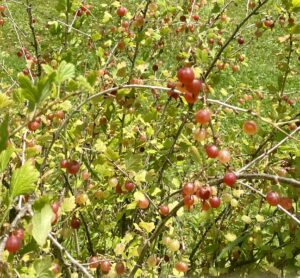As Promised … Gooseberries
Monday, July 1st, 2024By Bob Gaydos
Change is inevitable, they say, so the best course is to try to learn from it. For example, moving from an urban environment, which I lived in for most of my life, to a rural one required learning some new skills.
Some are more important than others. Pruning and harvesting gooseberry bushes without getting cut up by thorns is one of the more esoteric ones.
I’m learning.
“How’d you get those scratches on your arms?”
“It’s gooseberry season.”
“Huh?”
“Thorns.”
That was a recent conversation. With temperatures in the high 90’s, I went after the spreading bushes while wearing a T-shirt. Good thing the berries are juicy.
But not just that. They also have history. I’d never heard of gooseberries before becoming countrified and I imagine a few of you haven’t either. That’s because they were banned in America for decades.
Early in the 20th century, federal and state governments banned the growing of currants and gooseberries to stop the spread of white pine blister rust. Basically, the fungus was killing white pine trees, which were vital to the construction industry in the country.
It seems the blister rust fungus completes its life cycle only when gooseberries or currants and pine trees are living in close proximity to each other. Rather than cut down all the pine trees to save the gooseberry bushes, the decision was made to stop growing gooseberries to save the pine trees. Hard to argue with that.
Yet here we are with seven very healthy gooseberry bushes waiting to be harvested. What happened? Are they illegal? Not anymore.
Science saved the gooseberries as well as the pine trees. By mid-century, cross-breeding programs had been developed using remaining pine trees to develop varieties resistant to the rust. That meant gooseberries could be living safely in the neighborhood with the pine trees.
The federal ban was lifted in 1966, although some states still have restrictions on cultivating or shipping gooseberries.
But not ours.
In 2003, New York state passed a law to allow commercial growers and home gardeners to legally grow red currants, gooseberries and immune or resistant cultivars of black currants throughout the state. We’re legal.
For the record, according to info I gleaned from the Cornell Cooperative Extension, the berries I’ll soon be picking are the “Pixwell” variety developed in North Dakota in 1932. They are “easy to propagate, commonly sold three-foot bushes with small thorns … that bear medium-sized fruit that starts out green and turns purple upon ripening.”
Right. Funny how they kind of just glided through that “small thorns” item.
***
(Note: “The word ‘gooseberry’ comes from the old German name for the berries, Kräuselbeere, which means ‘curled or crimped berries.’ This name became grossularia in Medieval Latin, then groseille in French, and finally ‘gooseberry’ in English. The ‘r’ may have been dropped at some point during the transition.”
— This is from Google AI. You’re on your own regarding its accuracy.)

